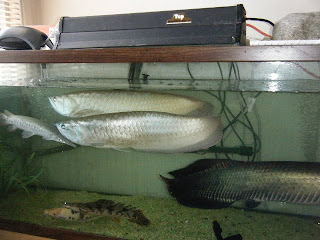The Clown Knife is one of the truly odd looking fish. The clown knife is found in the Southeast Asia river. They can reach up to 3 feet in the wild. In captivity, they max out at 24 inches. They are nocturnal hunters with poor eyesight. In captivity they are trained to take pellets and other foods such as shrimps, fillet, and smelts. No Clown Knife will look the same, some with no spots to many spots on their body. The bottom fin of the clown knife helps them move back and forth in the water. Their eyes are not too good for seeing, instead they use electrical sensors to spot preys and objects in the water, not unlike bats. In the native Southeast Asia like Thai and Vietnam, Clown knife is a delicacy. They are pounded into fish paste and made into fishballs and fishcakes.
 I have kept a clown knife for three years. The sides of the clown knife have equal amounts of spot numbering to 11 on each side. What I love most about this fish is the graceful movements it exhibits each time it surfaces the water to gulp in oxygen and goes back down, just like an olympic diver entering the water making a few splashes here and there. My clown knife is a very picky eater, it only eats pellets and feeder goldfishes. I should have feed it more variety of foods when it was small to train it from being so picky. I don't know if this is a feng shui fish but chinese people calls it the seven-star fish or the "guan dao," which resembles the great general Guan Yu's weapon. If anyone has a chance to get one or plan to get one, watch it eat feeder goldfish, it can fit 3 or 4 fish in its mouth at the same time (greedy!).
I have kept a clown knife for three years. The sides of the clown knife have equal amounts of spot numbering to 11 on each side. What I love most about this fish is the graceful movements it exhibits each time it surfaces the water to gulp in oxygen and goes back down, just like an olympic diver entering the water making a few splashes here and there. My clown knife is a very picky eater, it only eats pellets and feeder goldfishes. I should have feed it more variety of foods when it was small to train it from being so picky. I don't know if this is a feng shui fish but chinese people calls it the seven-star fish or the "guan dao," which resembles the great general Guan Yu's weapon. If anyone has a chance to get one or plan to get one, watch it eat feeder goldfish, it can fit 3 or 4 fish in its mouth at the same time (greedy!). 



